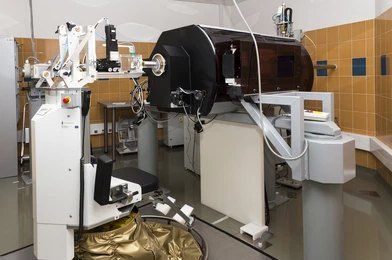The Benefits of Proton Therapy Over Traditional Radiation Therapy

In the realm of cancer treatment, radiation therapy has long been a cornerstone of care. This treatment involves the use of high-energy rays to target and destroy cancer cells. Traditionally, radiation therapy has been administered using X-rays, a form of electromagnetic radiation. However, in recent years, proton therapy has emerged as a more precise and effective alternative. Proton therapy in India is gaining increasing recognition due to its numerous advantages over conventional radiation therapy. For patients seeking advanced cancer treatments, proton therapy offers a safer, more effective option, minimizing side effects while achieving better clinical outcomes. Learn more about Proton Therapy in India.
What Is Proton Therapy?
Proton therapy, or proton beam therapy, is a type of cancer treatment that uses protons instead of X-rays to treat cancer. Protons are charged particles that can be precisely targeted and controlled to deliver high doses of radiation directly to the tumor site. Unlike traditional radiation therapy, which relies on X-rays that pass through both healthy and cancerous tissues, proton therapy allows for more targeted treatment, which can significantly reduce the damage to surrounding healthy tissues.
The primary advantage of proton therapy lies in its ability to deliver radiation to the tumor with minimal impact on the surrounding healthy organs. This precision is achieved through advanced technology that allows the proton beam to be aimed with remarkable accuracy. This makes proton therapy especially useful in treating tumors located near critical organs or in pediatric patients who are more sensitive to the long-term effects of radiation.
The Advantages of Proton Therapy Over Traditional Radiation Therapy
1. Precision and Targeting
One of the main advantages of proton therapy over traditional radiation therapy is its ability to deliver highly targeted doses of radiation to tumors. Traditional radiation uses X-rays, which pass through the body and irradiate healthy tissues along the way. The result is that surrounding healthy tissues can be damaged, leading to side effects such as fatigue, skin irritation, and damage to vital organs.
In contrast, proton therapy’s precision is due to the unique properties of protons. Protons have mass and energy, and when they reach a tumor, they release their energy directly at the site, minimizing damage to surrounding healthy tissue. This makes proton therapy an excellent choice for treating tumors near sensitive areas such as the brain, spinal cord, and eye, where even a small amount of radiation can cause serious side effects.
2. Reduced Side Effects
The reduced collateral damage of proton therapy means that patients experience fewer and less severe side effects compared to traditional radiation therapy. For patients receiving treatment for head and neck cancers, brain tumors, or cancers in pediatric patients, the potential for side effects is a serious concern. With proton therapy, the reduced exposure of healthy tissue to radiation can help minimize these risks.
Additionally, proton therapy’s precision enables doctors to deliver higher doses of radiation directly to the tumor without increasing the risk to surrounding tissues. This is particularly beneficial for patients with tumors that are difficult to treat or are in locations that are hard to reach using traditional radiation therapy.
3. Suitability for Pediatric Patients
Children are particularly vulnerable to the harmful effects of radiation. The long-term impact of radiation exposure on growing tissues and organs can lead to complications such as developmental delays, secondary cancers, and other long-term health issues. Proton therapy’s ability to spare healthy tissues makes it an ideal treatment option for pediatric patients.
In fact, proton therapy has been found to be highly effective in treating childhood cancers such as brain tumors, leukemia, and sarcomas. The ability to target the tumor precisely while reducing the exposure of healthy tissue to radiation is a major advantage in pediatric oncology.
4. Improved Tumor Control
For certain types of cancer, proton therapy has demonstrated superior tumor control compared to traditional radiation therapy. Protons can penetrate deeper into tissues, making it easier to treat tumors located in more challenging areas of the body. Moreover, proton therapy’s precision allows for higher doses of radiation to be delivered to the tumor, which can improve treatment outcomes.
Studies have shown that proton therapy can lead to better tumor control rates in cancers of the prostate, lung, and brain. For patients with these types of cancers, proton therapy may offer a higher likelihood of successful treatment and long-term remission compared to traditional X-ray radiation.
5. Less Risk of Secondary Cancers
Radiation therapy, while effective at treating cancer, can increase the risk of developing secondary cancers later in life. This risk is particularly significant in pediatric patients, whose cells are still growing and dividing. Proton therapy’s reduced radiation exposure to surrounding tissues can lower the risk of secondary cancers, making it a safer option for long-term health.
The use of proton therapy in pediatric oncology is gaining traction for this reason. Proton therapy can provide the necessary treatment to destroy cancer cells while minimizing the risk of future health complications, which is crucial for young patients.
Proton Therapy in India: A Growing Frontier
India has become a significant hub for proton therapy, with advanced facilities offering this cutting-edge treatment to patients from around the world. Proton therapy in India is now recognized for its quality, accessibility, and affordability. This makes it an appealing option for medical tourists seeking advanced cancer care at a fraction of the cost of treatment in Western countries.
Many top-tier hospitals and cancer treatment centers in India have invested in proton therapy technology, and the country is fast becoming a leader in the field of proton beam therapy. With highly trained specialists and state-of-the-art infrastructure, India is positioning itself as a key destination for proton therapy, particularly for international patients seeking the best in cancer treatment.
The demand for proton therapy in India is growing rapidly, as patients are becoming more aware of its advantages. With the accessibility of high-quality healthcare at competitive prices, India offers an attractive option for those seeking advanced cancer treatment, including those who may not have access to proton therapy in their home countries.
What to Expect During Proton Therapy Treatment
Proton therapy treatment usually involves a series of sessions spread over several weeks, depending on the type and location of the tumor. Each treatment session typically lasts between 15 and 30 minutes. The patient is positioned on a treatment table, and the proton beam is directed precisely at the tumor site using advanced imaging technology.
Before starting treatment, patients will undergo a thorough planning process to map out the exact location of the tumor. This process may include imaging tests such as CT scans or MRI scans, which help the medical team determine the most effective angles and doses for proton therapy.
Patients typically experience few side effects, and most can continue their daily activities during treatment. However, some may experience mild side effects such as fatigue or skin irritation, depending on the area being treated.
The Future of Proton Therapy
As proton therapy technology continues to advance, its use is expected to grow even further. Newer, more compact proton therapy machines are being developed, making the treatment more accessible and cost-effective. Additionally, ongoing research is focusing on improving the precision and effectiveness of proton therapy, leading to even better outcomes for cancer patients.
With the expanding role of proton therapy in cancer treatment, it is becoming increasingly clear that this approach offers significant advantages over traditional radiation therapy. From reduced side effects to improved tumor control, proton therapy is revolutionizing cancer treatment for patients around the world.



